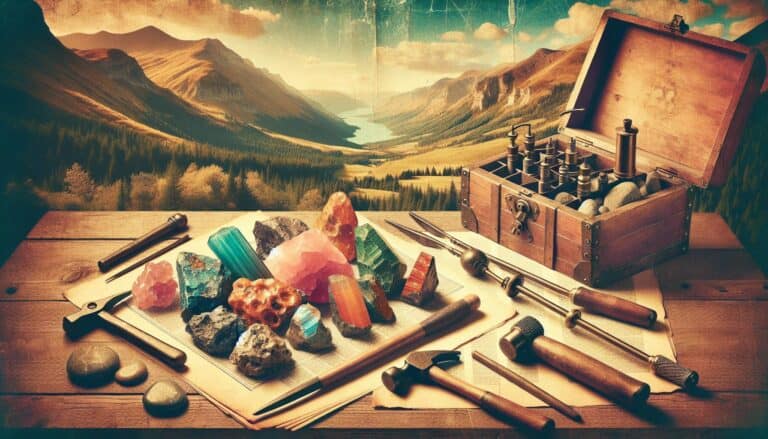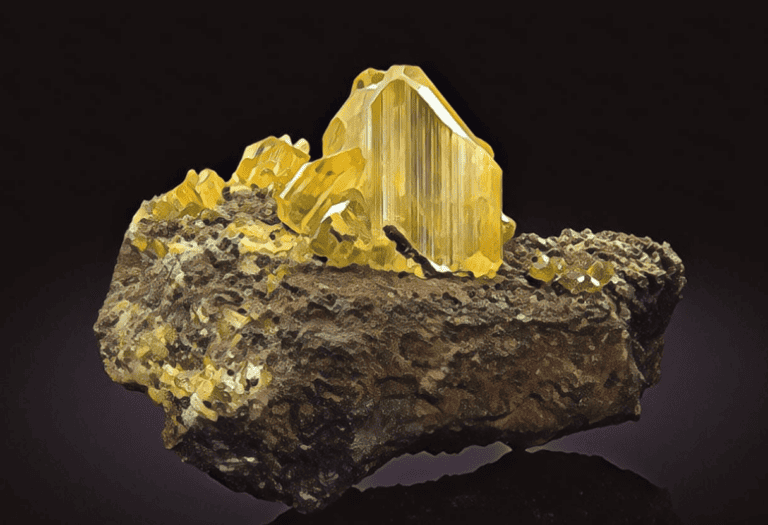Discovering the secrets of identifying jasper is like unlocking a geological treasure chest.
This beautiful gemstone, with its earthy tones and intricate patterns, is a favorite among collectors and jewelry enthusiasts.
But with so many varieties, how can you be sure you’ve got genuine jasper in your hands?
Uncover jasper’s secrets! Opaque, grainy, banded gemstone with white streak. Check hardness (6.5-7), non-magnetic, single refraction. Clean gently, store carefully for lasting beauty. Happy hunting!
How to Identify jasper Through Testing
Visual Inspection
Start by closely examining the stone’s surface with your eyes or a magnifying lens. Jasper is typically opaque with a smooth polish and has a grainy texture. Look for common jasper patterns like bands or ripples. A high-quality jasper should not have any shiny or reflective areas unless it’s been polished.
The Streak Test
Conduct the streak test by scraping the stone across a piece of unglazed porcelain. Jasper will typically leave a white or colorless streak. Beware of stones that leave a colored streak, as this may indicate a different mineral.
Magnet Test
Jasper is not naturally magnetic. If your stone is attracted to a magnet, it may be impure or misidentified. This simple test can quickly rule out jasper mixed with magnetic minerals.
Hardness Test
Check the hardness of your jasper by using the Mohs scale. Jasper has a hardness rating of about 6.5 to 7. It should be able to scratch glass, which has a lower rating, but not as easily scratch materials like a diamond.
Birefringence Test
Performing a birefringence test requires specialized equipment since jasper does not exhibit birefringence. If the stone shows double refraction, it’s likely not genuine jasper.
Checking The Diaphaneity
Jasper is an opaque stone. Hold it up to the light, and you shouldn’t see light passing through. Translucent or transparent qualities suggest the gem is not true jasper.
Single or Double Refraction
Using a refractometer, determine if the stone exhibits single or double refraction; jasper should only show single refraction. Double refraction will indicate the presence of another mineral.
Refractive Index Test
The refractive index (RI) test can be instrumental in identifying jasper, which has an RI range between 1.540 and 1.550. Stones falling outside this range are likely not authentic jasper.
Finding The Specific Gravity
Determine the specific gravity (SG) of the stone which should be about 2.5 to 2.9 for jasper. Values significantly outside this range might suggest that the stone is not jasper.
Identifying Jaspers in the Field
Recognizing jaspers while hiking or in the field involves a keen eye. Search for rocks with a dense, opaque appearance and the classic jasper smooth and lustrous surface.
Recognizing Potential Jasper Rocks
When you’re out exploring, look for potential jasper rocks, which may:
- Display a variety of colors, typically red, yellow, brown, or green
- Have a consistent, dense texture without visible pores or translucency
- Be found in areas with volcanic or sedimentary rocks
Discovering jasper can be a rewarding experience for gemstone enthusiasts. With these testing methods, you’ll have a set of tools at your disposal to identify genuine jaspers accurately.
Physical Characteristics of Jaspers

Jasper is a gemstone that boasts a variety of physical characteristics you’ll find both fascinating and practical in identification. When you come across a potential jasper specimen, first observe its omnipresent opaque quality. Unlike other gemstones, jasper’s opaqueness is a hallmark. You won’t see light passing through, which immediately sets it apart from translucent or transparent stones.
Next, your touch tells you much about its texture. Jasper has a smooth surface that can sometimes appear glassy. It’s this polished feel that might lead you to confuse it with other smooth minerals, but coupled with the opacity, you’re likely handling jasper.
The range of colors found in jasper is impressive, from fiery reds to earthy greens. Each piece often displays unique patterns or bands, which are the result of mineral impurities within the stone. These bands are not just visually stunning, they’re key identifiers. The diverse hues and patterns mean no two jaspers are ever completely identical—quite the fingerprint of Nature.
Don’t forget about weight. Jasper has a noticeable heft to it, which signals its dense composition. When you’re holding a piece, it should feel somewhat heavier than other stones of the same size.
Assessing the physical characteristics of jasper is both an art and a science. Through careful observation and tactile examination, you’ll quickly hone your skills in distinguishing this versatile gemstone. Keep these pointers in mind the next time you’re in the field or sifting through a collection, and you’ll know exactly what to look out for.
How Are Jasper Formed?
Jasper is formed through a fascinating geological process that’s both intricate and interesting. Your understanding of this process can deepen your appreciation for each unique jasper stone you encounter. Jasper is primarily silicon dioxide and forms when fine particulate materials are cemented by silica. The process usually occurs in volcanic ash flows or sedimentary deposits, transforming over time under intense heat and pressure.
As the sediments solidify, jasper begins to take shape. Iron oxides often provide the rich colors jasper is known for—reds, yellows, and browns are common. The presence of other minerals can result in jasper’s wide color palette and patterns. This variation means that each jasper stone is essentially one-of-a-kind. You’ll find that no two jaspers are exactly alike, due to the diverse conditions under which they form.
Interestingly, water often plays a role in the formation of jasper by aiding the dissolution and redeposition of silica. The hydrothermal circulation can lead to even more unique colorations and patterns. This is why you might find jaspers with orbicular or “egg-like” patterns, bands, or other spectacular visual effects.
Understanding the geological backstory of jasper will make your search for this beautiful stone even more rewarding. As you handle a piece of jasper, remember the immense geological forces that created it.
Preparation for Jasper Hunting
Before you embark on your journey to find jasper, there’s some groundwork to be done. Proper preparation can make the difference between a fruitful endeavor and a frustrating one. With some basic tools and safety measures, you’re set to turn rock hunting from a pastime into an art form.
Gathering the Right Tools
To enhance your chances of discovering genuine jasper, you’ll need the right set of tools. Even seasoned geologists rely on certain instruments to assist them in-field—so here’s what you should have on hand:
- Geologist’s hammer or a rock pick: A sturdy tool is essential for chipping off samples.
- Hand lens: This magnifier helps you inspect the details of rocks up close.
- Safety goggles: Protect your eyes when splitting rocks.
- Field guide: Carrying a book or electronic guide helps with instant identification.
- Streak plate: A streak test is crucial for color analysis.
- Hardness kit: Test for jasper’s renowned hardness.
- GPS device or map: Stay on course and mark your findings.
- Backpack: To carry your equipment and any jasper you find.
Also consider:
- Gloves: To prevent cuts and abrasions.
- Chisels: For more precise breaking.
- First aid kit: Always be prepared for minor injuries.
- Water bottle: Stay hydrated during your expedition.
Safety Considerations
Safety is paramount when hunting for jasper. Minimizing risk ensures you can enjoy your adventure without mishaps. Here’s a checklist for your well-being:
- Wear protective clothing: Durable boots and long pants shield against rough terrain and potential snake bites.
- Inform someone about your trip: Always let a friend or family member know your location and expected return time.
- Check weather and terrain: Be aware of environmental conditions that might affect your hunt.
- Be cautious in unknown areas: Stay alert and aware of your surroundings at all times, avoiding unstable ground.
- Have a communication plan: A charged phone or radio allows for contact in case of emergencies.
- Carry sufficient food and water: Energy levels need to be maintained, especially on longer trips.
Ensure you’re well-versed in first aid practices and consider the local wildlife. Sometimes, the greatest treasures are found in remote or rugged locations, and being prepared is your key to not only finding jasper but also ensuring a safe return from your adventure.
Handling and Care of Found Jasper

Cleaning and Storing Jasper
Once you’ve successfully identified and collected jasper, the next step is proper cleaning. Start by washing your stones with mild soap and warm water to remove any dirt or sediment. Use a soft brush to gently scrub the surface. For tougher grime, soaking the jasper in warm water for several hours may be necessary. Avoid using harsh chemicals, as they can damage the stone’s lustrous finish. After cleaning, pat your jaspers dry with a soft cloth to avoid water spots.
Storing your jaspers properly is key to preserving their natural beauty. Here are some tips for safe storage:
- Use soft fabric pouches or lined jewelry boxes to prevent scratches.
- Keep jaspers away from extreme temperatures and direct sunlight, which can cause colors to fade.
- Separating different types of stones avoids potential scratching since jasper has a hardness that can affect softer minerals.
For long-term storage, consider wrapping the stones in a soft cloth or placing them in a compartmentalized container, which provides both protection and easy accessibility. Remember, jaspers are durable, but they aren’t invincible. Treating them with care ensures they remain a part of your collection for years to come.
Conclusion: Confirming Jasper is Real
Identifying jasper is both an art and a science, and you’re now equipped with the knowledge to do it like a pro.
Remember, the key to confirming your find lies in a keen observation of physical characteristics, coupled with practical testing methods. Once you’ve found a specimen, handle it with care, clean it gently, and store it properly to maintain its allure. With these skills, you’ll be able to distinguish true jasper from imitators and appreciate the natural beauty of this versatile gemstone.
Keep exploring and trust your instincts; they’ll often lead you to the most extraordinary discoveries.







